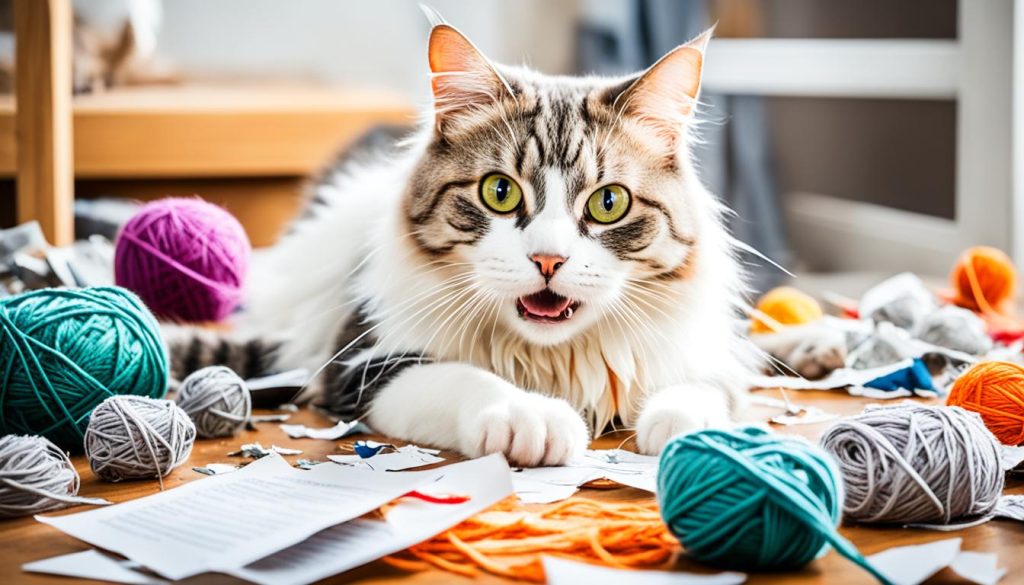Your cat has made your favorite chair into a scratching post again. You just got home and wanted to relax. This is what life is like for a cat owner – a mix of love and frustration. Those who have tried to understand their cat know this struggle well.
They will find the audiobook “Pet Peeves: The Hilarious Trials of Being a Cat Whisperer” relatable and fun. It is a humorous look at the challenges cat owners face. This unique world is full of both joy and chaos. It promises to be a fun listen.
The pet products industry is big, even in hard times. They help big foundations like the Morris Animal Foundation. But not every pet is lucky. Every year, about 4 million cats end up in U.S. shelters. Sadly, most of them are not adopted.
This shows why animal rescue and welfare need our support. It’s important to raise awareness. This way, more pets can find loving homes.
Alley Cat Rescue is one organization that is making a difference. They held the 2nd Annual “Free Feral Cat Spay Day” in 2011. Their goal was to help control the cat population and ease shelter burdens.
In 2012, the ACVO/Merial National Service Dog Eye Exam Event offered free check-ups. These are just some efforts to help animals.
This part of the story is an upbeat beginning. It prepares us for a discussion on cats’ unique behaviors. Camilla Gray-Nelson and her team at Dairydell Canine Center provide insights. They have helped over 9000 dogs and owners understand pet behavior better.
Caring for a cat is a delicate art. It needs both love and humor. You must be patient and find joy in the challenges. This is the key to a happy life with your feline friend.
Understanding Cat Behavior
Reading a cat’s actions can seem like decoding a hidden language. Many cat owners find joy, confusion, and sometimes annoyance in their pets’ behavior. Knowing the common traits of cats helps us get along better with them. This makes our home life with them more peaceful.

Typical Cat Traits
Cats show various behaviors when they interact with the world. Traits can differ between cats and breeds. Some are very friendly, while others enjoy being alone. Acts like kneading, purring, and grooming express their feelings or health. Understanding these behaviors helps us take good care of our cats and build strong relationships with them.
Common Misunderstandings
There are myths about cats that lead to misunderstandings. For example, thinking cats are aloof might just mean they value their independence. Many people also believe that cats can’t be taught, but with the right approach, cats can learn commands. Clarifying these misconceptions helps improve communication between cats and their owners, reducing stress for everyone.
Decoding Feline Body Language
It’s essential to understand a cat’s body language to interpret what they are saying. Everything from the tail’s movement to ear positions has meaning. A cat arching its back might be scared or ready to fight. A cat that’s relaxed and purring is usually happy. Learning to read these signals improves how we meet our cats’ needs and live with them peacefully.
Dr. Marty Becker emphasizes the need to address common behavior challenges for better pet ownership. Dr. Kate Hurley adds that shelter cats can get especially stressed, leading to unusual behaviors. Mastering the art of understanding cat language helps us care for our cats’ wellbeing better.
| Cat Behavior | Possible Interpretation |
|---|---|
| Kneading | Comfort and affection |
| Arching back | Fear or aggression |
| Purring | Contentment (or sometimes pain) |
| Flicking tail | Irritation or excitement |
| Slow blinking | Trust and relaxation |
As cat ownership grows, it’s more important than ever to understand cats. Learning their communication leads to a better, more joyful life with our beloved pets.
The Challenges of Cat Whispering
Being a cat whisperer requires dealing with many cat whispering difficulties. It’s all about understanding the unique behaviors and needs of cats. Good communication is key to building a strong bond with your cat. Cats are very independent animals. Figuring out why they act the way they do can be tough. But, learning how to respond correctly can create a stronger friendship with your cat.

Communicating with Cats
Understanding cats means noticing and interpreting their specific cues. When talking to cats, you have to read their body language and sounds. This type of talk is mostly without words. It’s about watching and understanding them. Things like how the tail moves, the ears, and the sounds they make can tell us a lot. Getting good at this can make life with your cat much better.
Quirky Cat Behaviors
Cats have many interesting habits that can puzzle or amuse us. They might suddenly run around, play for no reason, or groom in odd ways. These behaviors are part of what makes cats unique. By paying attention to these habits, we can learn a lot about our furry friends. It’s about accepting their quirks with understanding and love. This approach helps us connect deeply with them.
| Behavior | Possible Meaning |
|---|---|
| Sudden Sprints | Releasing pent-up energy |
| Headbutts | Seeking affection |
| Purring | Contentment or self-soothing |
| Hissing | Feeling threatened or annoyed |
Funny Pet Stories: Real-life Cat Owner Struggles
Living with cats is full of surprises and laughs. You never know what they’ll do next. The stories below show just how funny and unexpected a cat’s behavior can be.
Unexpected Feline Antics
Cat owners often find their pets doing the strangest things. For instance, a cat might sprint across the room for no reason and then suddenly stop to stare at a wall. These moments can be puzzling at first. But, they usually end up making the owner burst into laughter.
Hilarious Pet Moments
Cats provide endless entertainment. Whether they’re playing with a toy in a funny way or trying to fit into tight spots, it’s always a joy to watch. There’s a story about a cat falling into a pile of clean laundry while chasing a laser. The owner couldn’t stop laughing.
Such funny pet stories remind us of the joy our cats bring. Though they can be unpredictable, the laughter they inspire is priceless.

Pet Peeves: The Hilarious Trials of Being a Cat Whisperer
The life of a cat whisperer is funny, but it has its challenges. They deal with the quirky ways of cats, like odd behaviors and confusing actions. These miscommunications often lead to laughter, showing the difficulties faced by cat whisperers.
People often misunderstand what cat whisperers write about. Negative remarks, like those aimed at David B. Clear’s story, are not uncommon. These misunderstandings can lead to funny and frustrating situations for cat owners. For example, a writer faced criticism over the term “semi-viral,” which sparked a big debate.
Readers also get tired of seeing the same cat photos over and over. This overuse affects how they view articles. It’s like how cat whisperers feel when they can’t figure out their cats’ strange behaviors.
Writers sometimes make broad statements that don’t sit well with readers. “Pet Peeves,” a podcast, avoids these blanket statements. It looks at the specific joys and challenges of owning pets. These stories show the diversity of pet owner experiences.
We learn a lot from dealing with these pet peeves. It shows how the bond between pet owners and their cats is unique. Despite the challenges, the journey of a cat whisperer is filled with fun and understanding.
| Pet Peeves | Explanation |
|---|---|
| Miscommunications | Common misunderstandings between cats and their owners, leading to humorous situations. |
| Overused Stock Photos | The frequent appearance of the same images in articles, impacting reader engagement. |
| Reader Criticism | Instances where writers face hostility due to misinterpretation of their intentions. |
| Terminology Debates | Reader reactions to the use of specific terms, often leading to heated discussions. |
| Generalizations | Frustrations arising from universal claims about readers’ preferences and tastes. |
Funny cat behaviors and pet peeves are central to the cat whisperer’s experience. They form a community and share stories that bring cat lovers together.
Cat Communication Tips
Getting your cat’s behavior and signs of communication can make your friendship stronger. Knowing how to talk to your cat means you both can live in peace.
Building Trust with Your Cat
Getting your cat to trust you is the first big step. You need to be patient and do the same things every day. Here are some things to try:
- Consistent Routine: Stick to a schedule. Feed, play, and groom your cat at the same times to make them feel safe.
- Gentle Interactions: Always be calm around your cat. Don’t do anything surprising or make loud sounds. It could upset them.
- Positive Reinforcement: Reward your cat when they do something good with treats or kind words. This helps them learn and trust you more.
Effective Training Techniques
Teaching your cat can be fun. The right methods can change how they act and make talking with them easier. Here are some good ways:
| Technique | Description |
|---|---|
| Clicker Training | Use a clicker to show your cat when they do well, then give them a treat. It’s a clear way to talk to them. |
| Target Training | Get your cat to touch something with their nose or paw. You can teach them lots of things this way. |
| Lure Training | Lead your cat with a treat to do something, like sit or jump. Then, give them a treat right away. |
Good training needs you to do the same things over and over, be patient, and always be positive. This helps get past any language walls and makes your cat act better.
Medium found that readers sometimes don’t get the point because they don’t read closely. Just like with your cat, paying attention and being consistent can make them trust and understand you better.
Follow these tips for talking to your cat, teaching them, and making them trust you. This will make your friendship deeper and more rewarding.
How to Handle Litter Box Problems
Litter box issues can really stress out cat owners. But, by figuring out what’s causing the issue, you can help your cat use the litter box right. This will make your home a happier place for everyone.
Understanding Inappropriate Elimination
Cats may not use their litter box for different reasons. For example, it could be because of health issues like a urine infection. Or, it might be due to stressful changes at home, like moving or a new pet. These things could make your cat anxious and change their litter box habits.
Solutions for Litter Box Issues
First, choose the right spot for the litter box. Cats like a quiet, private place that’s not near food or their bed. Also, make sure the litter box is big enough. Most cats do okay with a standard size, but larger cats need more room.
What’s in the litter box matters too. Many cats like litter that clumps, such as clumping clay. But your cat might prefer something else. Feel free to try different types to see what your cat likes. Training your cat to use the litter box properly from the start is very important.
Keep an eye on your cat’s happiness and stress. Kittens might need extra help learning to use the litter box. If you’re moving an outdoor cat inside, they might need some extra training to use the litter box right.
Watch for any signs that your cat is unhappy. Making small changes to the litter box area can fix a lot of problems. By learning what your cat needs, you can solve litter box issues and keep your home clean and joyful for both you and your cat.
Entertaining Your Feline Friend
Entertaining your cat is key to its happiness. Ways to keep your cat busy include interactive toys and games. These not only fight boredom but keep your cat healthy too.
Interactive Toys and Games
Interactive cat toys are a hit for keeping your cat busy. Toys like laser pointers and feather wands offer hours of fun. Puzzle feeders make mealtime entertaining.
Games aren’t just for people. They get your cat moving and thinking. The Planet Dog Foundation gives back with every toy sold. This makes it a good choice for those who care about pets and the planet.
You can also make toys from everyday items like cardboard boxes. These are cheap and cheerful ways to keep your cat excited.
The Importance of Mental Stimulation
Mental exercise is as important for cats as it is for humans. This helps avoid pets being abandoned due to behavior issues. About 700,000 pets are put down in the US every year because of this.
Simple activities like training can do wonders for your cat’s mental health. They are also fun. Plus, they can save lives and money, showing their true impact.
So, daily games and training aren’t just fun—they’re essential for a happy pet. Including these in your routine really helps your feline friend stay healthy and joyous.
Dealing with Feline Temper Tantrums
Dealing with cat temper tantrums is tough for cat owners. It’s important to get why cats have mood swings. This knowledge helps us handle their tantrums. Events like changes in their space, disruptions in their routine, or health problems can spark these outbursts.
Controlling cat temper tantrums is a bit like managing a hit novel’s wild success. For example, Heidi Durrow’s book “The Girl Who Fell from the Sky” made it to #15 on the New York Times’ bestseller list. Just like successful novels, we need smart ways if we want to ease our cat’s unpredictable moods.
Making things steady, giving good feedback, and using stories can calm your cat’s aggression. Think of it as creating an amazing tale for your cat. Talking to your cat in patient and kind ways is crucial. This helps with their challenging actions.
Also, getting to know what makes your cat tick is important. Understanding your cat’s unique likes and dislikes is vital for reducing their tantrums. Doing this makes home life more peaceful for both you and your cat.
Conclusion
As our captivating journey ends, we see that being a cat whisperer is both hard and fun. This world of feline friends is filled with odd but lovable moments. Stories about cats’ funny actions and studies on what makes us laugh show it. In a way, understanding our cats’ strange habits is like finding universal jokes. It takes time and a good sense of humor to deal with our cat’s quirks.
In the late 1800s, people liked to keep birds like canaries and parrots. An 1889 Good Housekeeping article even suggested remedies for pet birds with asthma. But unlike birds, cats weren’t as popular then. Yet today, cats are beloved for the joy and company they bring.
Author Marc Tyler Nobleman, known for his 70+ books, would likely say that accepting our cats’ oddities builds a strong connection. From solving litter issues to understanding what our cats want through their body language, this article has valuable advice for cat owners. The key is to see the fun in their ways. It helps make our life with cats very rewarding.


